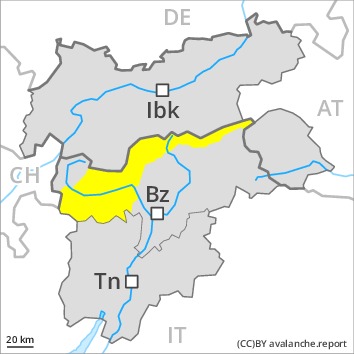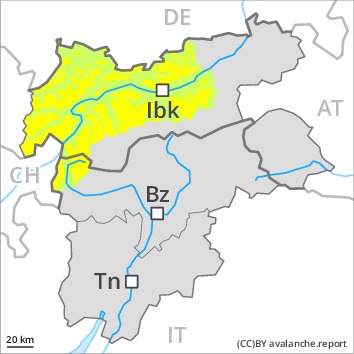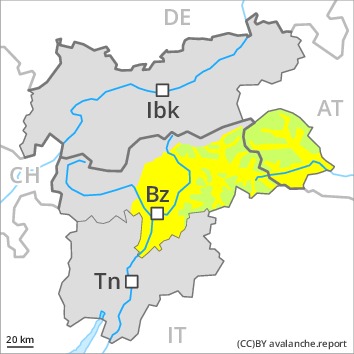
Danger level
 | 2400m
|
Avalanche Problem
 | | Persistent weak layer |
|  | |  |
 | | Gliding snow |
|  | |  |

High Alpine regions: Weakly bonded old snow requires caution. In addition further gliding avalanches are possible.
Avalanche prone weak layers exist deeper in the snowpack on steep shady slopes. Avalanches can in some cases be released by people and reach large size. The prevalence of the avalanche prone locations will increase with altitude. Caution is to be exercised at transitions from a shallow to a deep snowpack. In the Ortler Range the avalanche prone locations are more prevalent and the danger is greater.
On very steep grassy slopes and on sunny slopes only isolated gliding avalanches are possible, even quite large ones. Exposed parts of transportation routes can be endangered occasionally in the regions with a lot of snow.
Snowpack
dp.2: gliding snow
As a consequence of mild temperatures the snowpack settled. The snowpack is largely stable. Towards its surface, the snowpack is fairly homogeneous and its surface has a melt-freeze crust that is barely capable of bearing a load, in particular on steep sunny slopes as well as at low and intermediate altitudes.
High altitudes and the high Alpine regions: Towards its base, the snowpack is faceted and weak, especially on steep shady slopes, as well as adjacent to ridgelines and in gullies and bowls. The somewhat older wind slabs are in individual cases still prone to triggering.
Tendency
The avalanche danger will persist.

Danger level
 | 2200m
|
Avalanche Problem

Weak layers in the lower part of the snowpack necessitate defensive route selection.
Distinct weak layers in the lower part of the snowpack can be released by individual winter sport participants. Caution is to be exercised in particular on steep shady slopes above approximately 2200 m, as well as on steep sunny slopes above approximately 3000 m, especially in areas where the snow cover is rather shallow, as well as at transitions from a shallow to a deep snowpack, when entering gullies and bowls for example. Avalanches can be triggered in the faceted old snow and reach a dangerous size. These avalanche prone locations are difficult to recognise. In the regions with a lot of snow the situation is more favourable.
As a consequence of a moderate to strong wind, mostly small wind slabs formed in isolated cases. This applies especially on very steep shady slopes in the regions that are exposed to the foehn wind.
The current avalanche situation calls for meticulous route selection.
Snowpack
dp.1: deep persistent weak layer
dp.7: snow-poor zones in snow-rich surrounding
Steep shady slopes: The old snowpack will be prone to triggering in some places. Towards its surface, the snowpack is fairly homogeneous and has a loosely bonded surface. Towards its base, the snowpack is faceted and weak. Released avalanches and stability tests confirm the unfavourable bonding of the snowpack. Whumpfing sounds and the formation of shooting cracks when stepping on the snowpack are a clear indication of a weakly bonded snowpack. As a consequence of a moderate to strong wind, mostly small wind slabs formed in particular adjacent to ridgelines.
Very steep sunny slopes as well as low and intermediate altitudes: The snowpack is largely stable and its surface has a melt-freeze crust that is strong in many cases.
East and west facing slopes: The snowpack is largely stable and its surface has a melt-freeze crust that is not capable of bearing a load. Faceted weak layers exist deep in the snowpack above approximately 3000 m.
Tendency
The avalanche danger will persist.

Danger level
 | 2600m
|
Avalanche Problem

Caution is to be exercised in areas with glide cracks.
The danger of gliding avalanches will persist. On very steep grassy slopes and on sunny slopes more gliding avalanches are possible, even quite large ones. Areas with glide cracks are to be avoided.
Fresh and somewhat older wind slabs can be released in isolated cases on very steep shady slopes in high Alpine regions. This applies in particular adjacent to ridgelines.
Snowpack
dp.2: gliding snow
As a consequence of mild temperatures the snowpack settled. The snowpack is largely stable and its surface has a melt-freeze crust that is strong in many cases, in particular on very steep sunny slopes, as well as at low and intermediate altitudes. East and west facing slopes: The surface of the snowpack is frozen, but not to a significant depth.
Towards its base, the snowpack is faceted. This applies on steep shady slopes above the tree line, as well as on sunny slopes in high Alpine regions.
Tendency
The avalanche danger will persist.













